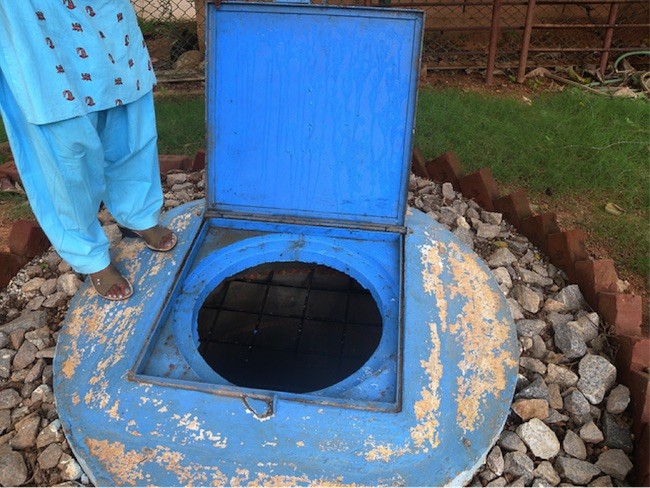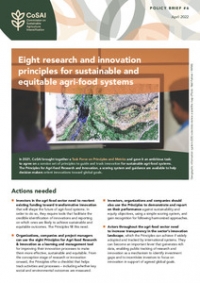As the earth’s surface grows hotter and precipitation becomes more variable due to the impacts of climate change, the world is in need of solutions to more effectively store water supplies. One potential solution is deceptively simple: store water in aquifers below the ground.
 A groundwater recharge well in India.
A groundwater recharge well in India.Photo: India Water Portal on Flickr
Unlike surface reservoirs, groundwater is shielded from the punishing rays of the sun. This means farmers, cities, and other water users can rely upon stored groundwater when water is in shortest supply at the surface. And since there are fewer and fewer ideal places to create new surface reservoirs around the world, “underground storage has a good future,” says Vladimir Smakhtin, theme leader on water availability and access at the International Water Management Institute (IWMI).
Dry season savoir
In addition to storing water more effectively than surface reservoirs, underground storage presents some intriguing possibilities to defuse seasonal water-related tensions between communities or even countries. Typically, monsoon rains and other heavy wet season weather events overwhelm river systems, causing disastrous flooding sometimes exacerbated by engineering projects along waterways and flood plains. Most of these excess waters are later lost as run-off to the ocean.
In river basins that experience high seasonal precipitation, populations impacted by flooding often blame upstream communities or countries for livelihood loses and other damages incurred during the wet season. Meanwhile, when the dry season later reduces river flows, tensions can flare again, with downstream water users accusing upstream users of withholding water.
In these situations, could underground water storage help communities in the upper and lower portion of a river basin better manage tensions associated with flood and drought cycles?
Some groundwater researchers think so. One 2012 study, for example, explores ways seasonal floodwaters might be captured or “harvested” in the upper reaches of Thailand’s Chao Phraya River basin to artificially recharge local aquifers and reduce catastrophic flooding downstream.
By increasing underground water storage capacity and simultaneously decreasing flood danger, this approach could make water users in certain river basins less likely to cast blame upon neighboring communities for excess or insufficient water supply, while enabling greater agricultural production and livelihood security.
Consequently, some researchers even recognize the potential for improved storage of wet season rains to ease transboundary water disputes at the international level. For instance, Smakhtin says research projects currently underway in Central Asia are exploring the prospects for managed aquifer recharge to reduce conflict potential among communities and countries sharing the rivers of the Fergana Valley, which are relied upon by Kyrgyzstan, Tajikistan, and Uzbekistan.
Not so fast: Potholes on the road to groundwater sustainability
It perhaps comes as little surprise that a growing chorus of water storage experts is optimistic about underground storage’s upside potential. It is a relatively straightforward and low-tech approach, and if implemented correctly, could represent a potent weapon in the battle to adapt to climate change and water-supply variability. But the same experts who champion the approach also voice caution.
First and foremost, effective underground water storage requires a site with the right soil conditions, appropriate aquifer types, and sufficient average annual rainfall. Many attempts at underground water storage in northwestern India, for example, have not proven successful because the selected aquifer recharge sites did not meet these criteria.
Even when an ideal site is chosen, groundwater contamination poses a significant threat to effective aquifer recharge. Concern about groundwater pollution at aquifer recharge sites has attracted the attention of the European Union. Paul Pavelic, a hydrogeological expert and groundwater specialist with IWMI, believes a lack of “cheap and effective methods to treat water” represents one of the main obstacles to wider use of underground storage around the world.
A third issue associated with underground storage may seem counterintuitive, but there must be demand for stored underground water from local water users. Some regions are in fact so groundwater-rich — such as the eastern Ganges basin — that the water table below the surface is quite shallow, with little capacity to receive additional water from the surface. In these cases, more intensive pumping of aquifers may be needed, to not only enable additional cropping seasons for farmers, but also reduce wet season flooding. (If these aquifers are strategically pumped during the dry season, the water table drops, so that when monsoon rains arrives, the aquifer may more effectively serve as a sponge to absorb floodwaters.)
In other instances, the concept of underground water storage must be introduced to communities that traditionally rely on rivers, lakes, and reservoirs to meet their water needs. “Some regions simply do not have a culture of using groundwater,”points out Smakhtin. “This mentality dies hard.” For that reason, it is crucial that these communities be consulted carefully about underground water storage proposals, and that they be involved as stakeholders once an underground storage project gets underway.
“Universally applicable”?
“With adequate technical knowledge, I consider [underground storage] a simple, cost-effective method that can successfully be used for years to come,” says Brindha Karthikeyan, a surface and groundwater specialist with IWMI’s Laos office. Its low price tag — at least compared to surface reservoirs — may also attract significant financial backing in time. Smakhtin predicts “investment banks shall consider underground storage, particularly if implemented at larger scale, as an equally viable solution to reconciling floods and droughts…. this is still to come.”
In the end, underground storage may not be the answer for communities living in water-stressed river basins, but it is an answer. Smart implementation of underground storage must be accompanied by corresponding advances in political and institutional structures governing groundwater use and management. But the technology has the potential to emerge as an important tool in the fight against water insecurity. Pavelic suggests underground storage may even be “universally applicable, as there are shortfalls experienced in water availability in space and time in even the wettest regions.”
Do you agree with Pavelic’s assessment that the technology’s spread “is inevitable” because it will allow us to diversify our approaches to water storage in an era of increasing climate uncertainty?
Can underground water storage add real depth to the water security of arid and semi-arid regions?















Comments
Interesting debate. Water storage is certainly one of the option to address drought and flood challenges, but it has to be done carefully.
Underground water storage can mitigate cross-basin tension- well, it may or may not depend upon total environmental factors.Simply storage and distribution of all precipitation is not enough to ease the tension once the tension is prevailing. Three things more to be taken into consideration. They are minimizing evaporation loss run off of water and improving water holding capacity of the soil.I believe this approach is not uncommon. If it is tried water availability is likely to improve in the lean period and supply will naturally increase. Forest cover over the soil plays a great role in this respect.
Dr. Jalil, I agree with you that surface vegetation can play an important role in facilitating groundwater recharge and improving soil's water-holding capacity --- especially in areas with large areas of impervious paved surfaces, where water cannot enter the soil and is instead lost as run-off. There are certain types of vegetation that can help improve the infiltration rate of water into the ground, especially during the early stages of significant rainfall. Research is being conducted into how surface vegetation can be combined with different methods of aquifer recharge --- i.e. recharge basins, injection wells, or both --- to most effectively replenish groundwater, especially in climates where precipitation is heavy and falls only periodically.
no problem. water is there in the underground. when it is available there it can be pumped out to meet our need.
Anada, you are right, it absolutely must be done carefully. To be effective, planning for underground water storage has to consider not just local soil conditions, aquifer types, and precipitation patterns, but also local political institutions and the needs of local water users from different economic sectors. Addressing all of these variables can be a bit of a juggling act. Thankfully, many pilot research projects for underground water storage are now underway, and we will be able to learn a great deal more about best practices and potential issues associated with this technology as a result. Learning these lessons will allow us to make even smarter choices in the future regarding how we choose to store water.
Pakistan provides an excellent place to test this underground storage concept at a landscape stage that is already on ground. With Climate Change projections of huge unpredictable floods in few days and politics of large storage dams ground water storage is the best option. Fortunately the office of the Inspector General of Forests in the Climate Change Division is working to get this concept on ground. Ramsar convention Secretariat is also fully involved. The flood plain management also provides good wetland habitat to wildlife and more.. We understand that the Chinese have done a lot at Yangte river.
Munaf, that is encouraging to hear that Pakistan is looking into the water storage possibilities allowed by managed aquifer recharge. For many countries experiencing significant glacial melt --- a list that includes not only Pakistan, but also India, China, Peru and Chile --- there is also a belief that underground water storage may emerge as a potential tool for capturing and storing those meltwaters before they are lost to the sea.
Is a great idea.I think can help peoples to solve a lot of problems in areas where the water supplies are unbalanced.The researches in this field can offer technical solutions but is need in my opinion a real political will
I really like this discussion and it is very timely. I am working on adaptive (adaptation) solutions this time in Africa in arid and semi arid countries where dams (10 to 14 m height collinear dams have been used as a solution both to prevent flooding and to collect water during floods but also normal rainwater in the rainy seasons). I am not very comfortable with dams. They may be a solution to collect water from floods and excessive rain but they are not the solution to conserve water as evaporation is probably 40 % in this particular country. Furthermore, the reservoirs created by those dams are the subject of pollution etc.. Yes underground storage is interesting but can you store trillions of cubic meter of water ? as in dams ? and once the water is stored how do you use it for irrigation , for e.g. micro scale irrigation and communal purposes and what are the costs involved ? in any case I am suggesting to test a pilot project and I need a bit more technical details .......Thank you
As praticing forester for over four decades in India, I strongly believe in the age old Biblical saying "What the eye can see the heart can grieve". In order to reduce tensions of water distribution, it is better to have unseen water(in the shape of underground/subsurface) than seen water.
In Tamilnadu, a Cadre in IFS (Indian Forest Service) which I belong to, I have seen dry rivers with sub- surface flow which the villagers have been taping to recharge their wells constructing sub-surface dams.
Kala jc
Former DG Forest India & Secretary to Government of India.
Authority dealing with the water particularly in Bangladesh should review the replies and if found something of use, may come forward to make way for better use. It is to be noted that deating with water requires multidiciplinary expertise service
Noble ideas indeed, however research is needed to determine the potential of the landscapes for future development prior to utilising it for water storage. With such a rapid in urban development we might see some of the areas where there water is stored earmarked for new development and the same water that was stored for beneficial use. I am saying this because I have seen many wetland areas disregarded and destroyed in spite of knowing their value and importance to peoples lives.